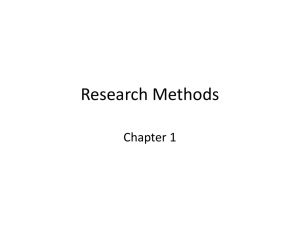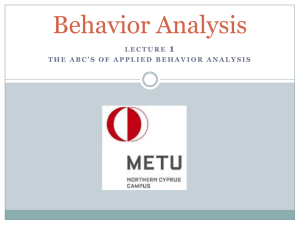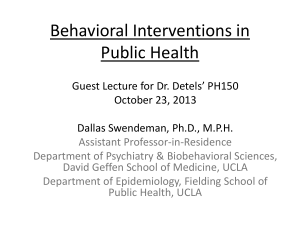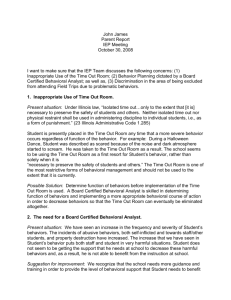Behavior modification
advertisement
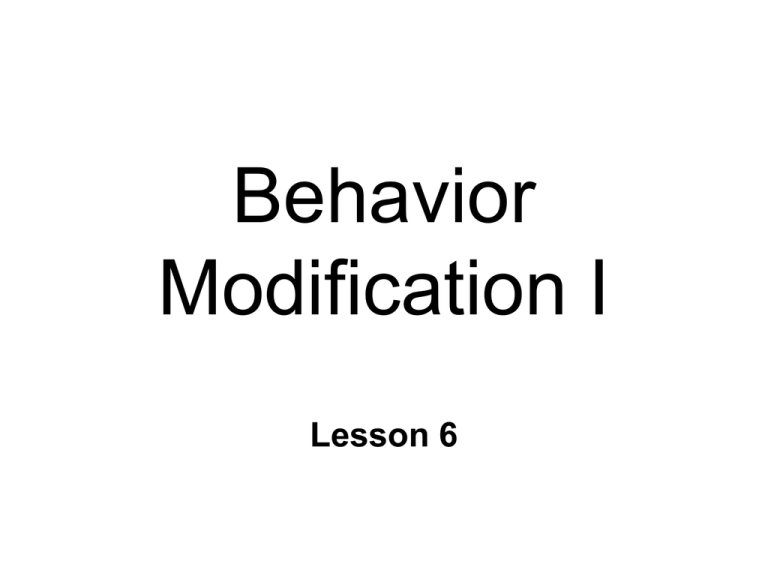
Behavior Modification I Lesson 6 Changing Our Behavior Behavior modification: Systematically applying behavior principles to the task of changing someone’s target behavior … our own or someone else’s. Janice & John Baldwin Operant conditioning principles ~ Some Applications Personal physical fitness motivation Psychotherapy panic attacks phobias Special education basic life skills social skills ~ Steps in Behavior Modification Scientific use of behavior (learning) principles Goal setting Behavioral Definitions Functional Analysis Objective measurement Data collection Evaluation ~ Goal Setting Identify target behavior the one we wish to change Excesses undesirable behaviors Deficits lack certain skills Developing human potential self-actualization ~ Behavioral Definitions Careful definition of target behavior Detailed (specific) & objective measurable in numerical units Example vague: I want to get better grades. effective: Study 2 hr for ea. class hr Take 3 pages notes ea. class Sleep 8 hrs per night ~ Behavioral Definitions Behavior vs traits Dead person rule Questions to answer What? When? Where? How often? How long? How to measure/record? ~ Chains of Behavior Accomplishment of overall goal Target behavior defined in smaller operant units linked together in chain of activities Can focus on weakest links first divide it into smaller behavioral units Basic skills integrated whole avoid coaches’ trap salsa dancing ~ Behavioral Definitions: Advantages Establishes performance level For target behavior B reward No B no reward Helps create rules to solve problems if goals not being met is a different approach needed? ~ Functional Analysis Identify controlling (maintaining) variables Antecedents Consequences Hypotheses on role of behavior D : B SR) ABC model (S Used to create behavioral interventions reduce unwanted behaviors while encouraging desirable one ~ Functional Analysis Antecedents promote target behavior inhibit target behavior Behavior desired / undesired other behaviors Consequences promote target behavior inhibit target behavior Functional Analysis: Example Self-injurious behavior (SIB) Iwata et al Antecedent parents attention directed elsewhere Behavior SIB Consequence attention directed towards child Operant phenomena? ~ Functional Analysis: Example Antecedent Tell child to eat stewed tomatoes Behavior SIB Consequence demand withdrawn Operant phenomena? ~ Functional Analysis: Purpose Identify relationship: A & C to B Context (A)/ Outcome (C) of Behavior Key: how does SR change B ? B = reinforcement B = punishment NOT that it appears appetitive/aversive ~ Intervention/Treatment Change controlling variables or B Antecedents Consequences behavioral deficits Preparation, reminders Reinforcement behavioral excesses Punishment or extinction Reinforce competing responses ~ The Dead Person Rule When behavioral excesses “Never ask someone to do something a dead person can do” Don’t ask them not to behave Punishment & extinction Promote competing response Fills behavioral void Alternate way to reach goal ~ Evaluation Multiple evaluations of process Is desired change occurring? Monitor data ABC diary, graphs More to come Re-assess treatment (controlling variables) Change antecedents? Change consequences? Evaluate again ~





